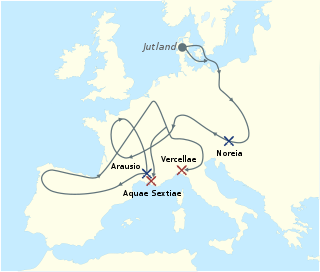
Year 100 BC was a year of the pre-Julian Roman calendar. At the time it was known as the Year of the Consulship of Marius and Flaccus and the First Year of Tianhan. The denomination 100 BC for this year has been used since the early medieval period, when the Anno Domini calendar era became the prevalent method in Europe for naming years.
This article concerns the period 69 BC – 60 BC.
This article concerns the period 79 BC – 70 BC.
80s BC is the time period from 89 BC – 80 BC.

This article concerns the period 109 BC – 100 BC.
This article concerns the period 139 BC – 130 BC.
Lucius Appuleius Saturninus was a Roman populist and tribune. He is most notable for introducing a series of legislative reforms, alongside his associate Gaius Servilius Glaucia and with the consent of Gaius Marius, during the last years of the second century BC. Senatorial opposition to these laws eventually led to an internal crisis, the declaration of the senatus consultum ultimum, and the deaths of Saturninus, Glaucia, and their followers in 100 BC.
Salvius Tryphon was an aulos player who was proclaimed king by the rebelling slaves of ancient Sicily during the Second Servile War against Rome.

The Third Servile War, also called the Gladiator War and the War of Spartacus by Plutarch, was the last in a series of slave rebellions against the Roman Republic known as the Servile Wars. This third rebellion was the only one that directly threatened the Roman heartland of Italy. It was particularly alarming to Rome because its military seemed powerless to suppress it.
The Servile Wars were a series of three slave revolts in the late Roman Republic:

The gens Licinia was a celebrated plebeian family at ancient Rome, which appears from the earliest days of the Republic until imperial times, and which eventually obtained the imperial dignity. The first of the gens to obtain the consulship was Gaius Licinius Calvus Stolo, who, as tribune of the plebs from 376 to 367 BC, prevented the election of any of the annual magistrates, until the patricians acquiesced to the passage of the lex Licinia Sextia, or Licinian Rogations. This law, named for Licinius and his colleague, Lucius Sextius, opened the consulship for the first time to the plebeians. Licinius himself was subsequently elected consul in 364 and 361 BC, and from this time, the Licinii became one of the most illustrious gentes in the Republic.
Publius Mucius Scaevola was a prominent Roman politician and jurist who was consul in 133 BC. In his earlier political career he served as tribune of the plebs in 141 BC and praetor in 136 BC. He also held the position of pontifex maximus for sixteen years after his consulship. He died around 115 BC.

The Cimbrian or Cimbric War was fought between the Roman Republic and the Germanic and Celtic tribes of the Cimbri and the Teutons, Ambrones and Tigurini, who migrated from the Jutland peninsula into Roman-controlled territory, and clashed with Rome and her allies. The Cimbrian War was the first time since the Second Punic War that Italia and Rome itself had been seriously threatened.

Manius Aquillius was a Roman politician and general during the late Roman Republic. He was a member of the ancient Roman gens Aquillia, probably a son of Manius Aquillius, consul in 129 BC. Aquillius served as Consul of Rome with Gaius Marius in 101 BC. Before his consulship, during the Cimbrian War, he had served as a legate under Marius in Gaul. He played a pivotal role during the Battle of Aquae Sextiae where he surprised the Teutones by attacking them from behind. As consul he crushed a slave revolt in Sicily. At the start of the First Mithridatic War he was defeated and captured by Mithridates VI of Pontus who had him executed by pouring molten gold down his throat.
Marcus Terentius Varro Lucullus, younger brother of the more famous Lucius Licinius Lucullus, was a supporter of Lucius Cornelius Sulla and consul of ancient Rome in 73 BC. As proconsul of Macedonia in 72 BC, he defeated the Bessi in Thrace and advanced to the Danube and the west coast of the Black Sea. In addition, he was marginally involved in the Third Servile War.
Lucius Licinius Lucullus was a politician and a general of the Roman Republic. He was the eldest son of Lucius Licinius Lucullus, the consul of 151 BC. He, however, did not achieve the political success of his father and failed to hold the consulship, reaching only the position of praetor in 104 BC. During his praetorship he first successfully put down the Vettian Revolt, a minor slave revolt in Campania, before being sent to take command in Sicily during the Second Servile War. He was later relieved of his command and prosecuted for embezzlement upon his recall to Rome. Being convicted, he was banished from the city and lived the remainder of his life in exile. He is the father of the more famous Lucius Licinius Lucullus, who defeated Mithridates and Tigranes in the Third Mithridatic War.
Publius Licinius Nerva was a Roman politician during the Late Roman Republic. As a propraetor he was assigned as Governor of Sicily in 104 BC at the outbreak of the Second Servile War.
The gens Titinia was a minor plebeian family at ancient Rome. Members of this gens are mentioned as early as the time of the decemvirs, but only a few held any magistracies, and none of them ever attained the consulship.





